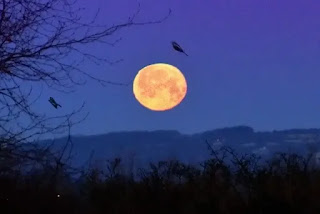Have you ever looked up at the night sky and been awestruck by the sight of a glowing orange moon? The phenomenon of the orange moon has captivated people for centuries, inspiring curiosity and wonder. In this article, we'll explore the science behind why the moon appears orange, when it's most visible, and the cultural significance it holds for different communities.
 |
| Moon Orange |
The orange moon is a rare and mesmerizing event that sparks interest and excitement among sky-watchers. Whether you're an amateur astronomer, a nature enthusiast, or simply someone who enjoys gazing at the beauty of the night sky, the orange moon is a sight to behold.
People often wonder why the moon appears orange, and what causes this unique color. Understanding the science behind the orange moon can help us appreciate the natural world around us and deepen our connection to the universe.
In addition to the scientific aspect, the orange moon also holds cultural significance for many communities around the world. From ancient myths and legends to modern-day beliefs and practices, the orange moon has been woven into the fabric of human culture for centuries.
By exploring the science and stories behind the orange moon, we can gain a deeper understanding of our place in the cosmos and the mysteries that surround us. So let's delve into the fascinating phenomenon of the orange moon and discover what makes it so special.
What causes the orange moon?
The orange color of the moon is caused by several factors that work together to create this unique phenomenon.
1. Atmospheric conditions
When the moon is near the horizon, its light has to travel through more of Earth's atmosphere. This causes the blue and green wavelengths of light to scatter more than the warmer colors of red, orange, and yellow. The result is that the moon appears to have an orange or reddish hue.
This effect is similar to what causes the sky to appear blue during the day. The blue and green wavelengths of light scatter more in the atmosphere, while the warmer colors of red, orange, and yellow pass through more easily. As a result, the sky appears blue.
2. Dust and pollution
The amount of dust and pollution in the atmosphere can also affect the color of the moon. When there are high levels of particles in the air, such as during a wildfire or a volcanic eruption, they can scatter the blue light and leave the moon with a reddish tint.
This effect is similar to what causes colorful sunsets. When the sun's light passes through more of the atmosphere, the blue and green wavelengths scatter more, leaving the warm colors of red, orange, and yellow to dominate.
3. Angle of the moon's light
The angle of the moon's light also plays a role in its color. When the moon is low in the sky, its light has to pass through more of the atmosphere than when it's high in the sky. This can cause the blue and green wavelengths to scatter more, leaving the orange and red colors to dominate.
This effect is why the moon appears larger when it's near the horizon. It's an optical illusion caused by our brains perceiving objects near the horizon as larger than they actually are.
4. Phase of the moon
The phase of the moon can also affect its color. When the moon is full, it reflects more light than during other phases. This can cause the orange or red hue to be more pronounced, especially if the atmospheric conditions are favorable.
The orange color of the moon is a result of a combination of factors, including the angle of the moon's light, atmospheric conditions, and the phase of the moon. Understanding these factors can help us appreciate the science behind this fascinating phenomenon and deepen our connection to the natural world.
When can you see the orange moon?
The orange moon is a fascinating phenomenon that captures the attention of skywatchers and stargazers alike. While it can be unpredictable, there are several factors that can increase your chances of seeing an orange moon. Here are some tips to help you catch a glimpse of this striking celestial event:
1. Time of year
The orange moon is more likely to occur during certain times of the year, depending on your location. In general, it's more common during the fall and winter months in the northern hemisphere, and during the spring and summer months in the southern hemisphere. This is because the moon's orbit is tilted relative to Earth's orbit around the sun, which causes it to appear at different angles throughout the year.
2. Time of night
The orange moon is most visible when it's rising or setting, as this is when it's closest to the horizon and has to pass through more of the atmosphere. This can cause the blue and green wavelengths of light to scatter more, leaving the warmer colors of red, orange, and yellow to dominate. To see the orange moon, you'll need to look for it just after sunset or just before sunrise.
3. Weather conditions
Clear weather conditions are ideal for seeing the orange moon. Clouds, haze, or smog can interfere with the moon's light and make it more difficult to see the orange color. It's a good idea to check the weather forecast before you head out to view the moon, and choose a night when the skies are clear and the air is relatively free of pollutants.
4. Location
The location you choose to view the orange moon can also make a difference. Being away from city lights and pollution can make the moon appear more vibrant and orange. A high vantage point can also provide a better view of the horizon, which can make it easier to see the moon as it rises or sets.
5. Equipment
While not strictly necessary, using binoculars or a telescope can enhance your view of the orange moon. This is especially true if you want to see the moon's craters and other features in more detail. A good pair of binoculars can also help you see the orange color more clearly, as they can magnify the moon and make it appear larger and more vibrant.
To see the orange moon, you'll need to plan ahead and choose the right time, location, and weather conditions. While it can be challenging to predict when the orange moon will occur, by following these tips, you can increase your chances of seeing this beautiful and mysterious phenomenon for yourself. So grab your binoculars, head to a high vantage point, and enjoy the magic of the orange moon!
The cultural significance of the orange moon
The orange moon has held a special place in the hearts and minds of people across different cultures throughout history. It has been the subject of myths, legends, and beliefs that have been passed down from generation to generation.
1. Native American beliefs
For many Native American tribes, the orange moon is a time of transformation and renewal. It is associated with the changing of the seasons and the cycle of life. Some tribes believe that the orange moon is a time of abundance and harvest, while others associate it with the coming of winter and the need to prepare for the cold months ahead.
The Cherokee people, for example, call the orange moon "the harvest moon" and see it as a time of thanksgiving for the gifts of the earth. They believe that the orange moon's light helps the crops ripen and mature, and they celebrate it with feasts, dances, and ceremonies.
The Lakota people, on the other hand, call the orange moon "the moon of changing seasons" and see it as a time of spiritual awakening and reflection. They believe that the orange moon's light helps them connect with their ancestors and the natural world, and they use this time to pray, meditate, and give thanks.
2. Chinese culture
In Chinese culture, the orange moon is celebrated during the Mid-Autumn Festival, also known as the Moon Festival. This festival is one of the most important holidays in China, and it is celebrated on the 15th day of the eighth lunar month, when the moon is at its fullest and brightest.
The Mid-Autumn Festival is a time of family reunions, traditional foods, and moon-gazing. It's believed that the orange moon is at its most beautiful on this day, and families often gather outside to enjoy the sight of the moon and eat mooncakes, a traditional pastry filled with lotus seed paste or other sweet fillings.
In Chinese folklore, the orange moon is associated with the moon goddess Chang'e and her companion, the jade rabbit. Legend has it that Chang'e was banished to the moon for stealing the elixir of life, and she now resides there with the jade rabbit, who keeps her company.
3. Hinduism
In Hinduism, the orange moon is celebrated during the festival of Sharad Purnima, also known as the Kojagiri Purnima. This festival marks the end of the monsoon season and the beginning of the harvest season, and it's believed that the orange moon's light is especially potent on this day.
According to Hindu mythology, Lord Krishna danced with the gopis (cowherd girls) under the light of the orange moon on Sharad Purnima. This event is commemorated with music, dance, and feasting, and it's seen as a symbol of the divine love between Krishna and his devotees.
4. Western culture
In Western culture, the orange moon has been the subject of countless works of art, literature, and music. Many poets and writers have been inspired by the beauty and mystery of the orange moon, and it's often used as a symbol of love, longing, and nostalgia.
In Shakespeare's play "Romeo and Juliet," for example, Romeo famously compares Juliet to the moon, saying, "Arise, fair sun, and kill the envious moon, who is already sick and pale with grief." In the song "Moon River," the orange moon is used to evoke a sense of romance and yearning.
In popular culture, the orange moon has appeared in movies, TV shows, and songs, and it's often used to create a romantic or dreamy atmosphere. In the movie “Moonstruck”, for example, the orange moon is a recurring motif that symbolizes the emotional and spiritual transformation of the main character.
The cultural significance of the orange moon is a testament to its enduring beauty and mystery. It's a reminder that, despite our differences, we are all united by our wonder and awe at the natural world. By learning about the different cultural beliefs and practices related to the orange moon, we can deepen our appreciation for this fascinating phenomenon and the rich tapestry of human experience that surrounds it.
👉 Read more posts with the same topic
Conclusion
In conclusion, the phenomenon of the orange moon is a captivating and mysterious occurrence that has fascinated people for centuries. By understanding the factors that contribute to its distinctive color and learning about its cultural significance, we can deepen our appreciation for this natural wonder.
Whether you are an avid stargazer or just someone who enjoys the occasional glimpse of the night sky, taking the time to observe and appreciate the orange moon can be a rewarding experience. By following the tips provided in this article, you can increase your chances of catching a glimpse of this beautiful phenomenon and even share your knowledge with others.
In today's world, where so much of our attention is focused on screens and technology, it's easy to forget about the beauty and wonder that surrounds us in the natural world. The orange moon serves as a reminder of the awe-inspiring power of nature and our connection to it.
So, the next time you see an orange moon shining in the night sky, take a moment to appreciate its beauty and reflect on the cultural significance that it holds. By doing so, you can deepen your understanding of the natural world and your place within it, and perhaps even inspire others to do the same.







0 Comments